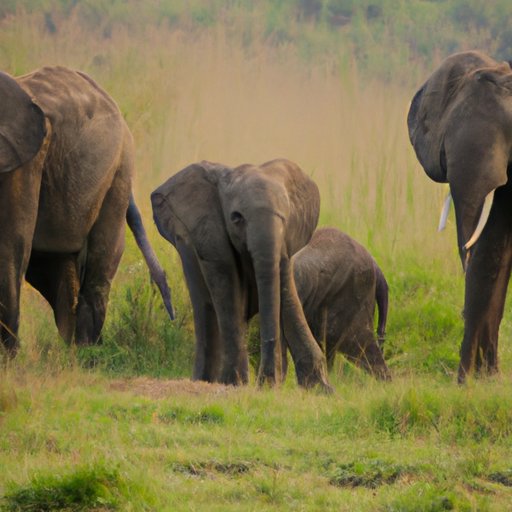Introduction
The elephant is an iconic species that has long been revered in many cultures. Elephants are the largest land mammals on Earth, with two distinct species: the African elephant (Loxodonta africana) and the Asian elephant (Elephas maximus). They are highly social creatures, living in complex family units led by a matriarchal leader. Despite their impressive size and intelligence, elephants are facing a serious threat to their survival due to human activity.

Counting Elephants: A Look at the Current Population of Elephants Worldwide
Estimating the total number of elephants worldwide is difficult due to the vastness of their habitats and their constantly shifting populations. However, according to the International Union for Conservation of Nature (IUCN), there are currently approximately 400,000-500,000 African elephants and 40,000-50,000 Asian elephants in the wild. The African elephant is found across sub-Saharan Africa, while the Asian elephant is found primarily in South and Southeast Asia.
The Decline of Elephant Populations: How Many Elephants Are Left in the World?
Despite the large numbers of elephants still remaining in the wild, their populations have been steadily declining over the past century. This decline can be attributed to several factors, most notably poaching and habitat loss. Poaching of elephants for their ivory tusks has been rampant in many areas, leading to a decrease in their numbers. Additionally, the destruction of their natural habitats has resulted in a decrease in available resources, making it more difficult for elephants to survive.
The Impact of Human Activity on the Global Elephant Population
Human activity has had a significant impact on the global elephant population. As humans expand into elephant habitats, they often disrupt the delicate balance between the two species. This disruption can lead to increased levels of conflict, as humans compete with elephants for resources such as water and food. In addition, the illegal killing of elephants for their tusks or other body parts has further contributed to the decline of elephant populations.

Conservation Efforts to Protect Endangered Elephants
In response to the decline in elephant populations, numerous international laws and organizations have been formed to protect these majestic creatures. For example, CITES (the Convention on International Trade in Endangered Species of Wild Fauna and Flora) has banned the international trade of ivory since 1989. Additionally, organizations such as the World Wildlife Fund (WWF) and the International Fund for Animal Welfare (IFAW) are working to protect elephant habitats and reduce human-elephant conflict. There are also numerous successful conservation programs that have been established to help protect and preserve elephant populations in various countries around the world.
Conclusion
Today, the global elephant population is estimated to be between 400,000-500,000 African elephants and 40,000-50,000 Asian elephants. Unfortunately, this number is declining due to poaching and habitat loss caused by human activity. Fortunately, there are numerous international laws and organizations working to protect and conserve elephant populations, as well as successful conservation programs in countries around the world. With continued efforts to protect these magnificent creatures, we can ensure that future generations will be able to continue to admire and appreciate elephants for years to come.


